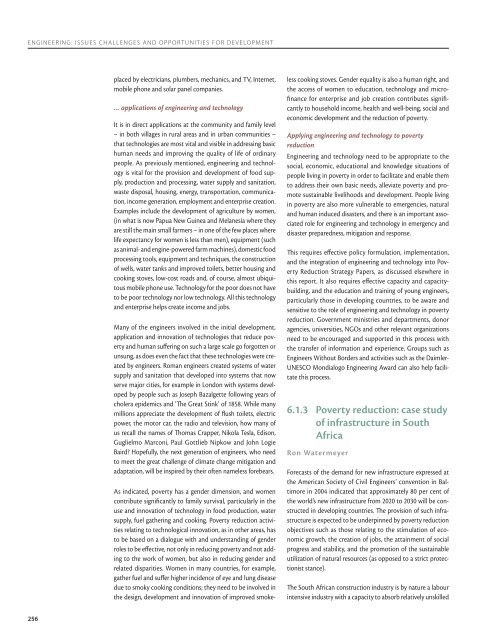Engineering: issues, challenges and opportunities for development ...
Engineering: issues, challenges and opportunities for development ...
Engineering: issues, challenges and opportunities for development ...
You also want an ePaper? Increase the reach of your titles
YUMPU automatically turns print PDFs into web optimized ePapers that Google loves.
ENGINEERING: ISSUES CHALLENGES AND OPPORTUNITIES FOR DEVELOPMENTplaced by electricians, plumbers, mechanics, <strong>and</strong> TV, Internet,mobile phone <strong>and</strong> solar panel companies.… applications of engineering <strong>and</strong> technologyIt is in direct applications at the community <strong>and</strong> family level– in both villages in rural areas <strong>and</strong> in urban communities –that technologies are most vital <strong>and</strong> visible in addressing basichuman needs <strong>and</strong> improving the quality of life of ordinarypeople. As previously mentioned, engineering <strong>and</strong> technologyis vital <strong>for</strong> the provision <strong>and</strong> <strong>development</strong> of food supply,production <strong>and</strong> processing, water supply <strong>and</strong> sanitation,waste disposal, housing, energy, transportation, communication,income generation, employment <strong>and</strong> enterprise creation.Examples include the <strong>development</strong> of agriculture by women,(in what is now Papua New Guinea <strong>and</strong> Melanesia where theyare still the main small farmers – in one of the few places wherelife expectancy <strong>for</strong> women is less than men), equipment (suchas animal- <strong>and</strong> engine-powered farm machines), domestic foodprocessing tools, equipment <strong>and</strong> techniques, the constructionof wells, water tanks <strong>and</strong> improved toilets, better housing <strong>and</strong>cooking stoves, low-cost roads <strong>and</strong>, of course, almost ubiquitousmobile phone use. Technology <strong>for</strong> the poor does not haveto be poor technology nor low technology. All this technology<strong>and</strong> enterprise helps create income <strong>and</strong> jobs.Many of the engineers involved in the initial <strong>development</strong>,application <strong>and</strong> innovation of technologies that reduce poverty<strong>and</strong> human suffering on such a large scale go <strong>for</strong>gotten orunsung, as does even the fact that these technologies were createdby engineers. Roman engineers created systems of watersupply <strong>and</strong> sanitation that developed into systems that nowserve major cities, <strong>for</strong> example in London with systems developedby people such as Joseph Bazalgette following years ofcholera epidemics <strong>and</strong> ‘The Great Stink’ of 1858. While manymillions appreciate the <strong>development</strong> of flush toilets, electricpower, the motor car, the radio <strong>and</strong> television, how many ofus recall the names of Thomas Crapper, Nikola Tesla, Edison,Guglielmo Marconi, Paul Gottlieb Nipkow <strong>and</strong> John LogieBaird? Hopefully, the next generation of engineers, who needto meet the great challenge of climate change mitigation <strong>and</strong>adaptation, will be inspired by their often nameless <strong>for</strong>ebears.As indicated, poverty has a gender dimension, <strong>and</strong> womencontribute significantly to family survival, particularly in theuse <strong>and</strong> innovation of technology in food production, watersupply, fuel gathering <strong>and</strong> cooking. Poverty reduction activitiesrelating to technological innovation, as in other areas, hasto be based on a dialogue with <strong>and</strong> underst<strong>and</strong>ing of genderroles to be effective, not only in reducing poverty <strong>and</strong> not addingto the work of women, but also in reducing gender <strong>and</strong>related disparities. Women in many countries, <strong>for</strong> example,gather fuel <strong>and</strong> suffer higher incidence of eye <strong>and</strong> lung diseasedue to smoky cooking conditions; they need to be involved inthe design, <strong>development</strong> <strong>and</strong> innovation of improved smokelesscooking stoves. Gender equality is also a human right, <strong>and</strong>the access of women to education, technology <strong>and</strong> microfinance<strong>for</strong> enterprise <strong>and</strong> job creation contributes significantlyto household income, health <strong>and</strong> well-being, social <strong>and</strong>economic <strong>development</strong> <strong>and</strong> the reduction of poverty.Applying engineering <strong>and</strong> technology to povertyreduction<strong>Engineering</strong> <strong>and</strong> technology need to be appropriate to thesocial, economic, educational <strong>and</strong> knowledge situations ofpeople living in poverty in order to facilitate <strong>and</strong> enable themto address their own basic needs, alleviate poverty <strong>and</strong> promotesustainable livelihoods <strong>and</strong> <strong>development</strong>. People livingin poverty are also more vulnerable to emergencies, natural<strong>and</strong> human induced disasters, <strong>and</strong> there is an important associatedrole <strong>for</strong> engineering <strong>and</strong> technology in emergency <strong>and</strong>disaster preparedness, mitigation <strong>and</strong> response.This requires effective policy <strong>for</strong>mulation, implementation,<strong>and</strong> the integration of engineering <strong>and</strong> technology into PovertyReduction Strategy Papers, as discussed elsewhere inthis report. It also requires effective capacity <strong>and</strong> capacitybuilding,<strong>and</strong> the education <strong>and</strong> training of young engineers,particularly those in developing countries, to be aware <strong>and</strong>sensitive to the role of engineering <strong>and</strong> technology in povertyreduction. Government ministries <strong>and</strong> departments, donoragencies, universities, NGOs <strong>and</strong> other relevant organizationsneed to be encouraged <strong>and</strong> supported in this process withthe transfer of in<strong>for</strong>mation <strong>and</strong> experience. Groups such asEngineers Without Borders <strong>and</strong> activities such as the Daimler-UNESCO Mondialogo <strong>Engineering</strong> Award can also help facilitatethis process.6.1.3Poverty reduction: case studyof infrastructure in SouthAfricaRon WatermeyerForecasts of the dem<strong>and</strong> <strong>for</strong> new infrastructure expressed atthe American Society of Civil Engineers’ convention in Baltimorein 2004 indicated that approximately 80 per cent ofthe world’s new infrastructure from 2020 to 2030 will be constructedin developing countries. The provision of such infrastructureis expected to be underpinned by poverty reductionobjectives such as those relating to the stimulation of economicgrowth, the creation of jobs, the attainment of socialprogress <strong>and</strong> stability, <strong>and</strong> the promotion of the sustainableutilization of natural resources (as opposed to a strict protectioniststance).The South African construction industry is by nature a labourintensive industry with a capacity to absorb relatively unskilled256

















